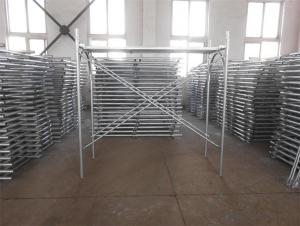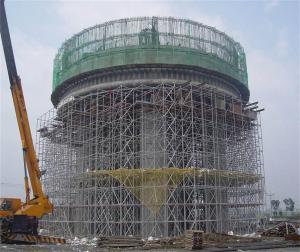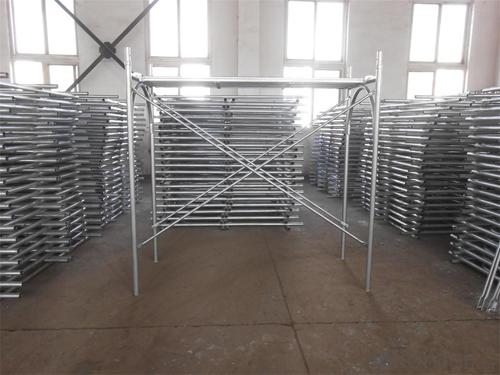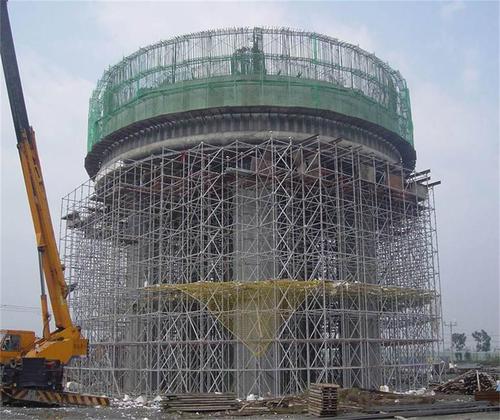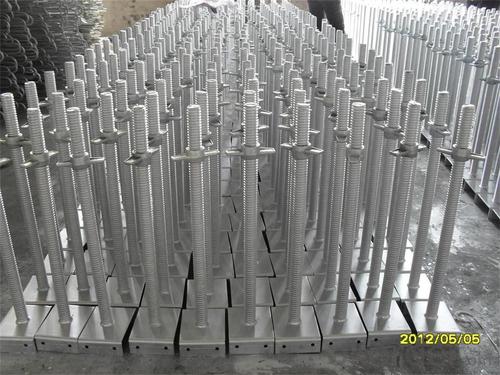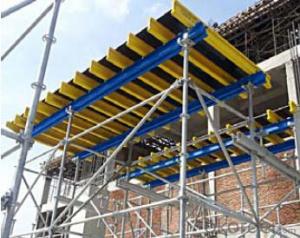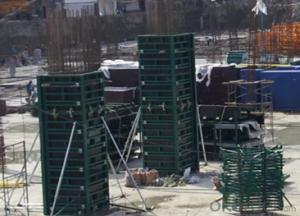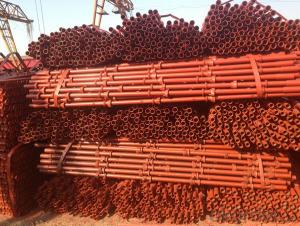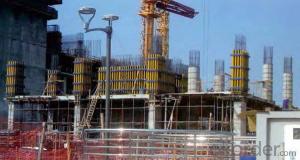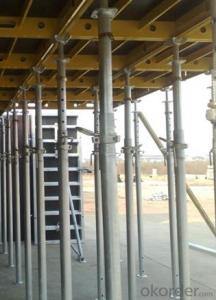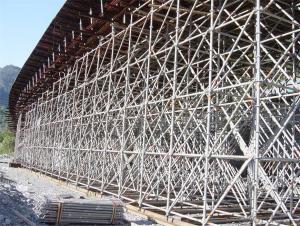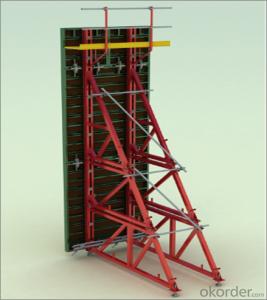Ring lock, Tower Scaffolding with Hot or Cold Galvanized Surface
- Loading Port:
- Shanghai
- Payment Terms:
- TT OR LC
- Min Order Qty:
- 1000 m²
- Supply Capability:
- 100000 m²/month
OKorder Service Pledge
OKorder Financial Service
You Might Also Like
1.Structure of Ring lock Description
Ringlock Scaffolding system is the most popular used Scaffolding system in the world.It will greatly reduce the cost because of the following advantages
Packaging & Delivery
Packaging Details:
Pallet or bag or upon client's request
Delivery Detail:
35days
2.Main Features of Ringlock
It will greatly reduce the cost because of the following advantages
1)Using less pipes
2)Easy to install
3)It can be used again and again for nearly 20years
3.Ring lock product pictures:
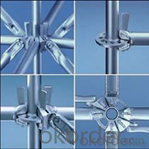
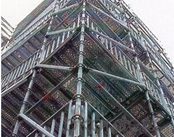
4.Ringlock Product Description
Type: ringlock scaffolding diagonal Brace
specification : Ø48.3×3.20
material:: steel Q235
Finished: Hot DIP galvanized, painted
Diagonal length(m) :Weight(kg)
0.9m * 1.25m 6.28
1.25m * 2.7m 11.45
5.FAQ
We have organized several common questions for our clients,may help you sincerely:
1)How about your company?
CNBM International Corporation, China National Building Materials (Group) Corporation, is one of the largest companies in China building material equipment industry, Our formwork and scaffolding are largely used in both domestic and all over world;
2)How many Scaffolding your company have?
Here comes our 5 types of Scaffolding systems:
- Cup lock Scaffolding(C-Lock Scaffolding)
- Ring lock Scaffolding
-Kwistage Scaffolding
-H-frame Scaffolding
-ID15 Scaffolding Tower, this type Scaffolding is the most widely used in construction, such like bridge.
3)How long can we receive the product after purchase?
Lead time is about 30days after getting the signed PI and deposit.
- Q: How does steel frame formwork handle the placement of embedded items and fixtures?
- Steel frame formwork is a versatile and efficient system used in construction projects to create concrete structures. When it comes to handling the placement of embedded items and fixtures, steel frame formwork offers several advantages. Firstly, steel frame formwork provides a high degree of flexibility and adaptability. The frames can be easily adjusted and modified to accommodate various embedded items and fixtures such as pipes, electrical conduits, and HVAC systems. This allows for precise positioning and integration of these elements within the concrete structure. Additionally, the steel frame formwork system is designed to support the weight of these embedded items and fixtures. The frames are made of robust steel sections that are capable of withstanding heavy loads, ensuring the stability and integrity of the formwork during the concrete pouring and curing process. Furthermore, steel frame formwork allows for efficient installation and removal of embedded items and fixtures. The formwork can be easily dismantled and reassembled, providing easy access for the installation of embedded items and fixtures. This saves time and effort during the construction process, as there is no need for additional formwork to be created or modified. Moreover, steel frame formwork ensures precise positioning and alignment of embedded items and fixtures. The frames are designed with accurate measurement systems, allowing for precise placement of these elements within the concrete structure. This helps to ensure that the final structure meets the required specifications and standards. Overall, steel frame formwork is an excellent choice for handling the placement of embedded items and fixtures in construction projects. Its flexibility, load-bearing capacity, ease of installation, and precision make it a reliable and efficient system for integrating these elements into concrete structures.
- Q: Can steel frame formwork be used for both small and large-scale bridge construction projects?
- Yes, steel frame formwork can be used for both small and large-scale bridge construction projects. Steel frame formwork offers several advantages that make it suitable for bridge construction. Firstly, steel is a strong and durable material that can withstand the heavy loads and stresses associated with bridge construction. It provides the necessary support and stability required for constructing both small and large-scale bridges. Additionally, steel frame formwork is highly versatile and flexible, allowing for customization and adaptability to different bridge designs and dimensions. This makes it suitable for constructing bridges of varying sizes and complexities. Furthermore, steel frame formwork is known for its efficiency and ease of use. It can be easily assembled, disassembled, and reused, which is beneficial for both small and large-scale projects. This not only saves time but also reduces costs associated with formwork materials. Moreover, steel frame formwork provides excellent concrete finish, ensuring the structural integrity and aesthetic appeal of the bridge. The smooth and even surface it creates helps in achieving the desired quality and appearance of the bridge. Overall, steel frame formwork is a suitable choice for both small and large-scale bridge construction projects due to its strength, versatility, efficiency, and ability to provide a high-quality finish.
- Q: What are the different types of safety systems used with steel frame formwork?
- Steel frame formwork commonly utilizes various safety systems to protect workers and prevent accidents or injuries. Fall protection is a frequently employed system, involving safety harnesses, lanyards, and anchor points to prevent falls from heights. This is particularly important as elevated work is often required. Another safety system used with steel frame formwork is edge protection, which includes guardrails or barriers to prevent accidental falls. This system safeguards workers from potential fall hazards and ensures their safety. Access systems provide safe and convenient entry and exit points for workers in steel frame formwork. These may consist of staircases, ladders, or platforms securely installed to allow access to different levels of the structure. Proper design and installation of access systems are necessary to ensure worker safety. Safety signage and warning systems are also commonly implemented in steel frame formwork. These include clear and visible signs that indicate potential hazards, such as electrical or confined space dangers. Audible or visual alarms can alert workers to potential risks or emergencies. These systems are crucial for maintaining a safe working environment and promoting worker awareness of potential hazards. Personal protective equipment (PPE) is an essential safety system in steel frame formwork. Workers are required to wear items like hard hats, safety boots, gloves, and eye protection to safeguard themselves from potential hazards. PPE should be provided to all workers and used in compliance with relevant safety regulations and guidelines. In conclusion, the various safety systems employed in steel frame formwork aim to ensure worker safety and prevent accidents or injuries. Fall protection, edge protection, access systems, safety signage and warning systems, and personal protective equipment are all vital components in creating a safe working environment.
- Q: How does steel frame formwork help in achieving accurate concrete thickness?
- Achieving accurate concrete thickness is made possible through the use of steel frame formwork, which provides a rigid and stable structure for pouring and shaping the concrete. Acting as a mold or template, the steel frame holds the wet concrete in place until it sets and hardens. One of the primary benefits of steel frame formwork is its resistance to deformation or movement during the pouring and curing process. This guarantees that the concrete maintains its intended thickness and shape, leading to precise and consistent outcomes. Furthermore, the steel frame formwork allows for precise control over the dimensions and alignment of the concrete. It can be adjusted and leveled to the desired thickness, ensuring that the concrete is poured to the correct depth. This feature is particularly crucial in applications where specific thickness requirements are essential, such as in constructing walls, slabs, or columns. Moreover, the steel frame formwork provides a smooth and even surface finish to the concrete. The sturdy structure of the steel frame prevents any bulges, warping, or irregularities, resulting in a uniformly thick concrete structure. This not only enhances the aesthetic appeal of the final product but also ensures its structural integrity. In summary, steel frame formwork plays a vital role in achieving accurate concrete thickness by offering stability, precision, and control throughout the pouring and shaping process. Its resistance to deformation and ability to maintain dimensional accuracy guarantee that the concrete meets the required thickness specifications, resulting in resilient and high-quality structures.
- Q: How does steel frame formwork handle the construction of suspended slabs and beams?
- Steel frame formwork is a highly versatile and efficient system for constructing suspended slabs and beams. The steel frames provide robust support and stability, ensuring the proper alignment and leveling of the formwork. This enables the construction of large spans and complex geometries with ease. The formwork panels are easily adjustable and can be reused multiple times, making it a cost-effective solution. Additionally, the use of steel frame formwork allows for faster construction timelines and ensures high-quality finishes. Overall, steel frame formwork is an excellent choice for handling the construction of suspended slabs and beams due to its strength, flexibility, and efficiency.
- Q: What are the recommended maximum heights for steel frame formwork systems?
- The recommended maximum heights for steel frame formwork systems can vary depending on factors such as the design, load capacity, and safety regulations. However, it is generally advised to consult the manufacturer's guidelines and engineering experts to determine the specific maximum heights for a particular steel frame formwork system.
- Q: What is the meaning of steel frame support structure?What is the support?
- Steel structure is a kind of economic and effective structure type for high-rise buildings, especially in seismic areas, and the supporting structure of steel frame is better than the frame structure,
- Q: How does steel frame formwork improve the quality of concrete?
- Steel frame formwork improves the quality of concrete in several ways. Firstly, steel frame formwork provides a stable and rigid structure for pouring concrete, ensuring that it maintains its shape and form during the curing process. This helps to prevent any deformation or warping of the concrete, resulting in a more accurate and precise final product. Secondly, the steel frame formwork allows for the easy and efficient placement of reinforcement bars within the concrete. This is crucial for enhancing the structural integrity and strength of the concrete. The steel frame provides a secure framework for positioning and holding the reinforcement bars in place, preventing any displacement or movement during the pouring and curing process. Additionally, steel frame formwork allows for the precise control of concrete pouring, ensuring a consistent and uniform distribution of the concrete mixture. This helps to eliminate any voids or air pockets in the concrete, resulting in a more dense and durable final product. Moreover, steel frame formwork provides a smooth and even surface for the concrete, minimizing the need for additional finishing or surface treatments. This can save time and resources, while also improving the overall aesthetics of the concrete. Overall, steel frame formwork plays a vital role in improving the quality of concrete by providing stability, facilitating the placement of reinforcement bars, allowing for precise pouring, and creating a smooth surface finish.
- Q: Can steel frame formwork be used in combination with other construction techniques, such as post-tensioning?
- Yes, steel frame formwork can be used in combination with other construction techniques, such as post-tensioning. Steel frame formwork provides a strong and durable support structure for concrete during the pouring and setting process. Post-tensioning is a technique used to reinforce concrete structures by applying tension to steel cables after the concrete has set. By using steel frame formwork, the concrete structure can be accurately shaped and supported, while the post-tensioning technique can be applied to increase the overall strength and load-bearing capacity of the structure. The steel frame formwork provides a stable platform for the post-tensioning cables to be installed and tensioned, ensuring proper distribution of forces and enhancing the structural performance of the building or infrastructure. The combination of steel frame formwork and post-tensioning can be particularly beneficial for large-scale construction projects, where the use of precast or prestressed concrete elements is common. This combination allows for efficient construction processes and improved structural performance, resulting in cost savings and enhanced durability. It is important to note that the specific design and implementation of steel frame formwork in combination with post-tensioning should be done by experienced professionals following industry standards and guidelines. Proper coordination and collaboration between the structural engineers, formwork specialists, and post-tensioning experts are crucial to ensure a successful and safe construction process.
- Q: How does steel frame formwork affect the overall fire resistance of a building?
- The overall fire resistance of a building can be significantly affected by the presence of steel frame formwork. Compared to materials like wood or concrete, steel is a durable and strong material that can withstand high temperatures for a longer duration. As a result, the use of steel frame formwork can provide a higher level of fire resistance and structural integrity during a fire incident. The steel frame formwork acts as a protective barrier, preventing the rapid spread of fire throughout the building. It also helps minimize fire damage by maintaining its structural stability under extreme heat conditions. This is crucial for ensuring the safety of occupants and allowing them more time to evacuate. Furthermore, the use of steel frame formwork can enhance the fire resistance of other building components such as floors, walls, and ceilings. By reinforcing these components with steel formwork, they become more resistant to fire, thereby increasing the overall fire performance of the building. However, it should be noted that the fire resistance of a building does not solely rely on the presence of steel frame formwork. Other factors such as fire protection measures, insulation materials, and the overall design of the building also play a critical role in determining the fire resistance rating. Therefore, it is essential to carefully consider and incorporate all these factors into the building design to achieve optimal fire safety.
Send your message to us
Ring lock, Tower Scaffolding with Hot or Cold Galvanized Surface
- Loading Port:
- Shanghai
- Payment Terms:
- TT OR LC
- Min Order Qty:
- 1000 m²
- Supply Capability:
- 100000 m²/month
OKorder Service Pledge
OKorder Financial Service
Similar products
Hot products
Hot Searches
